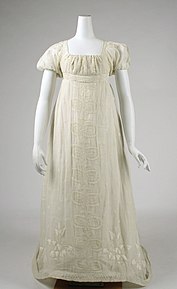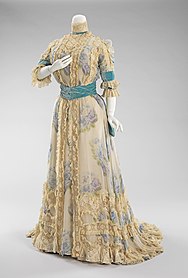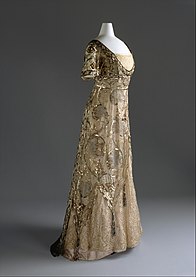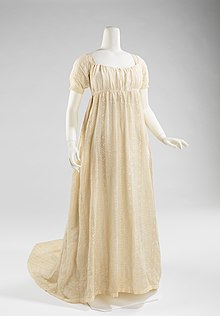Evolution of Womens Fashion 1920 to 2000




Various examples of dresses
A apparel (also known as a frock or a gown) is a garment traditionally worn past women or girls consisting of a skirt with an fastened bodice (or a matching bodice giving the effect of a ane-piece garment).[i] It consists of a height slice that covers the torso and hangs down over the legs. A dress can be any one-piece garment containing a brim of any length, and can be formal or casual.
A dress can take sleeves, straps, or be held up with elastic around the chest, leaving the shoulders bare. Dresses also vary in colour.
The hemlines of dresses vary depending on modesty, weather, fashion or the personal taste of the wearer.[2]
Overview [edit]
Dresses are outer garments made up of a bodice and a skirt and tin be made in 1 or more pieces.[3] [4] Dresses are generally suitable for both formal wear and casual vesture in the West for women and girls.[4]
Historically, dresses could also include other items of clothing such every bit corsets, kirtles, partlets, petticoats, smocks, and stomachers.[5] [6] [7]
History [edit]
11th century [edit]
In the 11th century, women in Europe wore dresses that were like to men'southward tunics and were loose, with a hemline reaching to below the knees or lower.[8] By the end of the century, these dresses featured a tighter fit on the artillery and women'due south upper bodies.[viii] Dresses were made snug by featuring slits on the sides of the dress that were pulled tight in gild to fit a woman's figure.[9]
16th century [edit]
Starting in the 1550s, center- and upper-form women in Europe wore dresses which included a smock, stays, kirtle, gown, front end, sleeves, ruff and a partlet.[5] Undergarments were not worn underneath.[5] In England, Queen Elizabeth dictated what kinds of dresses women were immune to wear.[10] French women were inspired by Spanish-way bodices and also wore ruffs.[10] French dresses were known as marlottes.[11] In Italy, dresses were known as ropa and semarra. [11] Dresses in the 16th century also displayed surface decoration such as embroidery, with blackwork being especially popular.[12]
Women'southward dresses in Russia during both the 16th and 17th centuries identified a adult female'south place in club or their family.[xiii]
17th century [edit]
Holland, as a heart of textile production, was a specially noted expanse of innovation in apparel way during the 17th Century.[7] In Spain and Portugal, women wore stomachers [7] while in England and France, dresses became more "naturally" shaped.[7] Lace and slashing were popular decorations.[7] Skirts were total, with regular folds and the overskirt immune the display of an underskirt of contrasting fabric.[7] Necklines became lower too.[seven] Embroidery that reflected scientific discoveries, such as newly discovered animals and plants were popular.[14] In the British Colonies, multi-piece dresses were also popular, though less luxurious.[15] Wealthy women living in the Spanish or Dutch colonies in the Americas copied the fashions that were pop from their homelands.[16]
The three-piece apparel, which had a bodice, petticoat and gown, was popular until the last 25 years of the century, in which the mantua, or a one-piece gown, became more popular.[17] Corsets became more important in dresses past the 1680s.[18]
Working women, and women in slavery in the Americas, used unproblematic patterns to create shifts, wool or linen petticoats and gowns and cotton dresses.[19] The bottoms of the skirts could be tucked into the waistband when a woman was near a cooking or heating fire.[nineteen]
18th century [edit]

Illustration of 18th century French women
Large, triangular silhouettes were favored during the 18th century, skirts were broad and supported past hoop underskirts.[20] [21] 1-piece gowns remained popular until the middle of the century.[22] During the 1760s in France, hoop petticoats were reduced in size.[23] Lighter colors and lighter fabrics were also favored.[24] In Colonial America, women most frequently wore a gown and petticoat, in which the skirt of the gown opened to reveal the petticoat underneath.[25] Women also had riding habits which consisted of the petticoat, jacket and a waistcoat.[25]
French style regarding dresses became very fast-irresolute during the later part of the 18th century.[26] Throughout this menstruation, the length of stylish dresses varied simply slightly, between ankle-length and floor-sweeping.[2] Betwixt 1740 and 1770, the robe à la française was very popular with upper-class women.[27] In France, the Empire style became popular after the French Revolution.[28] This more simple fashion was as well favored by Josephine Bonaparte,[28] wife of Napoleon. Other popular styles during the revolution included tunic dresses and the negligée à la patriot, which featured the blood-red, white and bluish colors of the flag.[29]
19th century [edit]

Women'south dresses in the 19th century began to be classified by the time of day or purpose of the dress.[30] High-waisted dresses were popular until effectually 1830.[30]
Early on nineteenth century dresses in Russia were influenced by Classicism and were made of sparse fabrics, with some semi-transparent.[31] Elizabeth Vigée Le Brun wore these types of dresses with a short brim (reaching to her ankles) when she lived in Russia between 1785 and 1801[31] and many Russian women copied her style.[31] Past the 1840s, Russian women were turning to what was in way in Europe.[32]
Europeans styles in dresses increased dramatically to the hoopskirt and crinoline-supported styles of the 1860s,[33] then fullness was draped and drawn to the back.[34] Dresses had a "twenty-four hours" bodice with a high neckline and long sleeves, and an "evening" bodice with a low neckline (decollete) and very brusk sleeves. In Russia, metal hoopskirts were known as "malakhovs."[32] Skirts of the 1860s were heavily decorated.[34]
To sleep, women in the American Westward wore flooring-length dresses of white cotton with high collars displaying decoration.[35] Various Native American people, such equally the Navajo and the Mescalero Apache began to suit the designs of their dresses to expect more like the European Americans they came in contact with.[36] Navajo women further adapted the European designs, incorporating their own sense of beauty, "creating hózhó." [37]
Paper sewing patterns for women to stitch their ain dresses started to be readily available in the 1860s, when the Butterick Publishing Visitor began to promote them.[38] These patterns were graded past size, which was a new innovation.[39]
The Victorian era'due south dresses were tight-fitting and decorated with pleats, rouching and frills.[28] Women in the United States who were involved in clothes reform in the 1850s establish themselves the middle of attending, both positive and negative.[xl] Past 1881, the Rational Dress Society had formed in reaction to the restrictive apparel of the era.[28]
20th century [edit]

In the early twentieth century, the look popularized by the Gibson Girl was fashionable.[41] The upper part of women'southward dresses in the Edwardian era included a "pigeon chest" look that gave way to a corseted waist and an due south-shaped silhouette.[41] Women called their dresses "waists" if one-piece, or "shirtwaists," if it consisted of a skirt and a blouse.[42] The bodice of the dresses had a boned lining.[42] Informally, wealthy women wore tea gowns at domicile.[43] These garments were looser, though non every bit loose as a "wrapper," and made of expensive textile and laces.[43]
Past 1910, the Edwardian look was replaced with a straighter silhouette.[44] French designer, Paul Poiret, had a huge impact on the wait of the time.[44] Designs developed by Poiret were available in both boutiques and as well in section stores.[45] Popular dresses of the time were one-piece and included lingerie dresses which could be layered.[46] At around the same fourth dimension, in the United states of america, the American Ladies Tailors' Association adult a clothes called the suffragette suit, which was practical for women to work and move around in.[47] [48] Another innovation of the 1910s was the ready availability of mill-fabricated wear.[49]
Waistlines started out loftier and past 1915 were below the natural waist.[46] By 1920, waistlines were at hip-level.[46] Between 1910 and 1920 necklines were lower and dresses could exist short-sleeved or sleeveless.[50] Women who worked during Globe State of war I preferred shorter dresses, which eventually became the dominant manner overall.[24] In add-on to the shorter dresses, waistlines were looser and the dominant colors were black, white and grayness.[51]
By 1920, the "new adult female" was a trend that saw lighter fabrics and dresses that were easier to put on.[52] Younger women were also setting the trends that older women started to follow.[52] The dresses of the 1920s could exist pulled over the head, were brusque and straight.[53] It was acceptable to wear sleeveless dresses during the twenty-four hour period.[53] Flapper dresses were pop until finish of the decade.[54]
During World War Ii, dresses were slimmer and inspired past military uniforms.[28] After WWII, the New Look, promoted by Christian Dior was very influential on fashion and the look of women's dresses for near a decade.[55]
Since the 1970s, no 1 dress type or length has dominated fashion for long, with short and talocrural joint-length styles ofttimes appearing adjacent in manner magazines and catalogs.[56]
Use [edit]
In most varieties of formal wearing apparel codes in Western cultures, a dress of an appropriate mode is mandatory for women. They are as well very pop for special occasions such every bit proms or weddings.[57] For such occasions they, together with blouse and skirt, remain the de facto standard attire for many girls and women.
Formal dress [edit]
In western countries, a "formal" or white tie dress code typically means tailcoats for men and total-length evening dresses with opera-length gloves for women. A most formal clothes for women are total-length ball or evening gowns with evening gloves. Some white tie functions also request that the women wear long gloves past the elbow.
Basic dress [edit]
A basic dress is a usually dark-colored dress of simple design which tin can be worn with various accessories to suit different occasions.[58] Unlike kinds of jewelry, belts, scarves, and jackets can exist worn with the basic dress to dress upwardly or downwardly.[59] A little blackness clothes is an case of a basic dress.
Bodycon dress [edit]


A bodycon dress is a tight figure-hugging clothes, often made from stretchy textile.[60] The name derives from "body confidence"[61] or, originally, "body conscious", transformed into Japanese in the 1980s as "bodikon".
Party dress [edit]

A party dress is a dress worn especially for a party. Dissimilar types of party such equally children's party, cocktail political party, garden party and costume party would tend to require different styles of dress.[63] [64] One classic style of party dress for women in modernistic society is the little blackness dress.[65]
Types of dresses [edit]
Time period [edit]
-

16th century wearing apparel.
-

Calico clothes, circa 1656-1693
-

Late 17th century, wool and metallic thread.
-

Russian dress, 1717
-

Wearing apparel circa 1750–1800, wool and chintz.
-

Clothes circa 1770–1800, chintz and printed cotton
-

Classic empire line gown, muslin with tambour, circa 1805
-

Dress and outfit, circa 1855
-

Belatedly 19th century
-

Rayon with seed beads, circa 1925
-

Dance dress, 1939
-

24-hour interval clothes, circa 1940s
-

Bluish satin cocktail wearing apparel, 1959
-

Printed dress, circa 1960
-

Jersey wearing apparel, circa 1970
Lengths [edit]
-

Gown or Long Dress - a adult female's formal dress, usually having a floor-length skirt.[66]
-

Maxi dresses (c.1970) - maxi is a term used since the late 1960s[67] for ankle-length, typically breezy dresses.[66]
-

Midi clothes - a "midi" is used to refer to any dress or skirt that has a hem which hits at mid-calf – halfway between the knee and ankle.[66]
-
Knee length dress- Hemline ends at articulatio genus height.[66]
-

Mini dress (1960s) - a very short clothes that terminates above the knee.[66] [68]
-

Micro dress (right) with minidresses, 2008.- A microdress is an extremely brusque version of a mini.[69]
See also [edit]
- History of Western fashion
- Mainland china poblana
- Granny apparel
- Jumper dress
- Lingerie dress
- Listing of dresses
- Mantua
- Sack-dorsum gown (also known as robe à la française)
- Squaw dress
References [edit]
Citations [edit]
- ^ Condra, Jill (2008). The Greenwood Encyclopedia of Clothing Through Earth History: 1801 to the present. Greenwood Publishing Group. p. 59. ISBN9780313336652.
- ^ a b Davis, Michael (2007). Art of dress designing (1st ed.). Delhi: Global Media. ISBN978-81-904575-7-vi.
- ^ "The definition of clothes". Lexicon.com . Retrieved 29 Jan 2018.
- ^ a b Picken 1957, p. 101.
- ^ a b c Edwards 2017, p. xx.
- ^ Cunningham 2003, p. 20.
- ^ a b c d due east f g Edwards 2017, p. 30.
- ^ a b Newman 2001, p. 113.
- ^ Newman 2001, p. 114.
- ^ a b Edwards 2017, p. 21.
- ^ a b Bigelow 1970, p. 110.
- ^ Edwards 2017, p. 23.
- ^ Pushkareva 1997, p. 120.
- ^ Edwards 2017, p. 34.
- ^ Staples & Shaw 2013, p. 222.
- ^ Havelin 2012, p. 27.
- ^ Edwards 2017, p. 35.
- ^ Bigelow 1970, p. 126.
- ^ a b Havelin 2012, p. 26.
- ^ Bigelow 1970, p. 135.
- ^ Bigelow 1970, p. 137.
- ^ Edwards 2017, p. 49.
- ^ Pietsch 2013, p. 400.
- ^ a b "Costume". Funk & Wagnalls New World Encyclopedia . 2017 – via EBSCOhost.
- ^ a b "A Colonial Lady's Wear: A Glossary of Terms". Colonial Williamsburg . Retrieved 24 January 2018.
- ^ Pietsch 2013, p. 397-398.
- ^ Delpierre 1997, p. 15-16.
- ^ a b c d e "A Cursory History of Women'due south Mode". Makers. 7 September 2016. Retrieved 24 Jan 2018.
- ^ Bigelow 1970, p. 157.
- ^ a b Bigelow 1970, p. 183.
- ^ a b c Pushkareva 1997, p. 242.
- ^ a b Pushkareva 1997, p. 244.
- ^ Krohn 2012, p. 36.
- ^ a b Bigelow 1970, p. 188.
- ^ Krohn 2012, p. 37.
- ^ Parezo & Jones 2009, p. 384.
- ^ Parezo & Jones 2009, p. 384-385.
- ^ Darnell 2000, p. 27.
- ^ "Butterick History". Butterick Patterns . Retrieved 24 January 2018.
- ^ Cullen-DuPont, Kathryn (2014). Encyclopedia of Women'due south History in America. Infobase Publishing. pp. 71–72. ISBN9781438110332.
- ^ a b Darnell 2000, p. 9.
- ^ a b Darnell 2000, p. 11.
- ^ a b Darnell 2000, p. 13.
- ^ a b Darnell 2000, p. 49.
- ^ Darnell 2000, p. l.
- ^ a b c Darnell 2000, p. 53.
- ^ Greenberg, Molly (1 March 2017). "100 Years of Feminist History Explained in 10 Women's Piece of work Suits". UNC . Retrieved 24 Jan 2018.
- ^ Khan, Sarah (16 November 2016). "The fascinating history and evolution of the female pantsuit". Marie France Asia . Retrieved 24 Jan 2018.
- ^ Richards 2010, p. 100.
- ^ Darnell 2000, p. 57.
- ^ Richards 2010, p. 100-101.
- ^ a b Darnell 2000, p. 73.
- ^ a b Darnell 2000, p. 77.
- ^ Darnell 2000, p. 105.
- ^ Parezo & Jones 2009, p. 383.
- ^ "The History of Hemlines". Women's History Network. 1 September 2013. Retrieved 24 January 2018.
- ^ Pundir, Nirupama (2007). Style engineering science: today and tomorrow. New Delhi: Mittal Publications. ISBN978-81-8324-203-v.
- ^ "Definition of "basic dress"". Retrieved 28 July 2013.
- ^ Janssen, Jo Ann; Ellis, Gwen (2003). Dress Like a Meg Bucks Without Spending Information technology! . Fleming H. Revell Company. ISBN978-0800758325.
- ^ Martin, Tracy (2014). The Little Blackness Dress: How to dress perfectly for any occasion. Ryland Peters & Small. ISBN 9781782490210.
- ^ Narumi, Hiroshi. "Street Style and Its Meaning in Postwar Nippon" Fashion Theory: The Periodical of Dress, Torso & Culture, Volume xiv, Number four, December 2010, pp. 415–438 (24). doi:10.2752/175174110X12792058833816.
- ^ "Apparel Paco Rabanne 1967", Out of London, Paris, New York 1965–1968, V&A
- ^ Alexandra Blackness (2007), The Party Dress, ISBN978-i-902686-59-2
- ^ Nora Villa (1996), Children in Their Party Clothes, ISBN978-0-89676-202-2
- ^ Amy Holman Edelman (1998), The trivial blackness clothes, ISBN978-1-85410-604-9
- ^ a b c d e The Faddy Sewing Book . Vogue Patterns. 1975. p. 337.
- ^ Cumming, Valerie; Cunnington, C.Due west.; Cunnington, P.E. (2010). The lexicon of manner history (Rev., updated and supplemented [ed.]. ed.). Oxford: Berg. p. 130. ISBN9780857851437.
- ^ Delamore, Philip (29 March 2007). "Mini and Midi". The Wedding ceremony Dress: A Visual Sourcebook of Over 200 of the Most Cute Gowns Ever Made. Pavilion Books. p. 122. ISBN9781862057647.
- ^ Cumming, Valerie; Cunnington, C. W.; Cunnington, P. E. (September 2010). The Lexicon of Manner History. Berg. ISBN9781847887382.
Sources [edit]
- Bigelow, Marybelle S. (1970). Way in History: Wearing apparel in the Western World . Minneapolis, Minnesota: Burgess Publishing Company. ISBN9780808702610.
fashion in history bigelow.
- Brockmamn, Helen Fifty.: The Theory of Fashion Design, Wiley, 1965.
- Darnell, Paula Jean (2000). From Victorian to Vamp:Women'southward Wearable 1900-1929. Reno, NV: Fabric Fancies. ISBN9781887402156.
- Cunningham, Patricia A. (2003). Reforming Women's Fashion, 1850-1920: Politics, Health and Art. Kent, Ohio: The Kent State University Press. ISBN0873387422.
- Delpierre, Madeleine (1997). Clothes in France in the Eighteenth Century. Translated by Caroline Beamish. New Haven: Yale Academy. ISBN9780300071283.
- Edwards, Lydia (2017). How to Read a Dress: A Guide to Changing Fashion from the 16th to the 20th Century. London: Bloomsbury Academic. ISBN9781472533272.
- Havelin, Kate (2012). Buckskin Dresses and Pumpkin Breeches: Colonial Fashions from the 1580s to 1760s . Minneapolis: 20-Commencement Century Books. p. 26. ISBN9780761358879.
dresses.
- Krohn, Katherine (2012). Calico Dresses and Buffalo Robes: American West Fashions from the 1840s to the 1890s. Minneapolis: Twenty-Beginning Century Bookos. ISBN9780761380528.
- Newman, Paul B. (2001). Daily Life in the Middle Ages. Jefferson, North Carolina: McFarland & Company, Inc. ISBN9780786408979.
- Parezo, Nancy J.; Jones, Angelina R. (June 2009). "What's in a Name?: The 1940s-1950s 'Squaw Dress'". American Indian Quarterly. 33 (three): 373–404. doi:x.1353/aiq.0.0058. S2CID 162233209.
- Picken, Mary Brooks (1957). The Fashion Dictionary: Cloth, Sewing, and Dress equally Expressed in the Language of Fashion. New York: Funk & Wagnalls Company.
- Pietsch, Johannes (September 2013). "On Unlike Types of Women's Dresses in France in the Louis Sixteen Menstruum". Manner Theory: The Journal of Apparel, Body & Culture. 17 (iv): 397–416. doi:10.2752/175174113X13673474643084. S2CID 191612745.
- Pushkareva, Natalia (1997). Women in Russian History: From the Tenth to the Twentieth Century. Translated and edited by Eve Levin. Armonk, New York: 1000.E. Sharpe. ISBN9780765632708.
- Richards, Marlee (2010). America in the 1910s. Minneapolis: Twenty-First Century Books. ISBN9780822534372.
- Staples, Kathleen A.; Shaw, Madelyn (2013). Clothing Through American History: The British Colonial Era. Santa Barbara, California: Greenwood. ISBN9780313084607.
- Stoykov, Lubomir (2016). Theoretical problems of fashion, Sofia: National University of Fine art. ISBN 978-954-9799-11-eight
- Tozer, Jane, and Sarah Levitt: Fabric of Society: A Century of People and Their Clothes 1770–1870, Laura Ashley Ltd., 1983; ISBN 0-9508913-0-4
External links [edit]
-
 Media related to Dresses at Wikimedia Commons
Media related to Dresses at Wikimedia Commons

0 Response to "Evolution of Womens Fashion 1920 to 2000"
Post a Comment